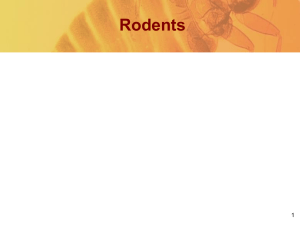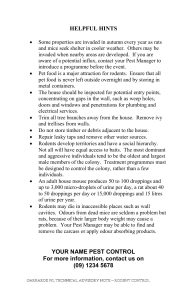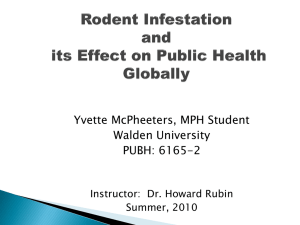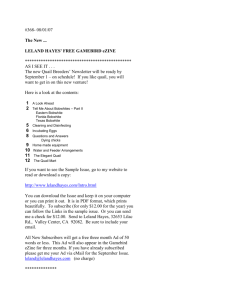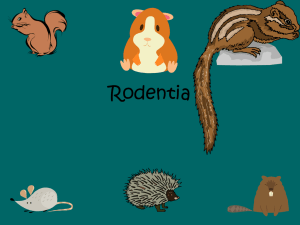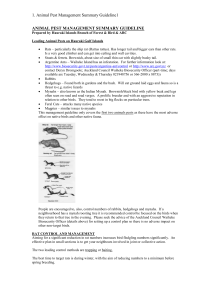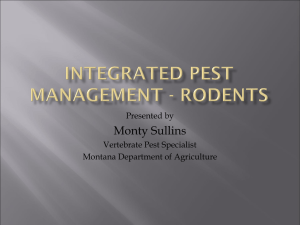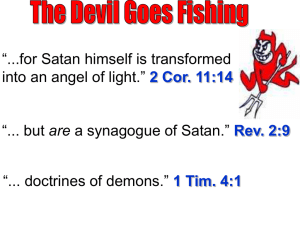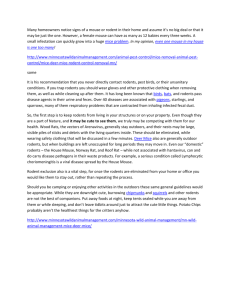Rodents - StopPests.org
advertisement
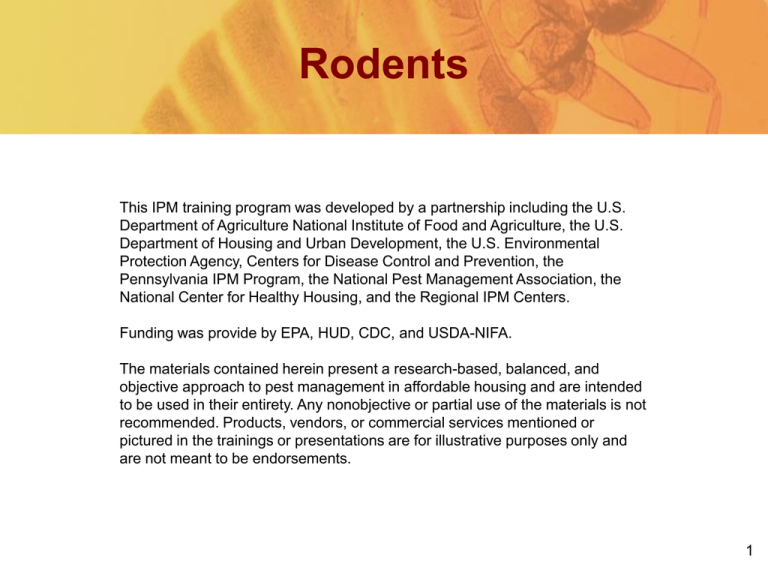
Rodents This IPM training program was developed by a partnership including the U.S. Department of Agriculture National Institute of Food and Agriculture, the U.S. Department of Housing and Urban Development, the U.S. Environmental Protection Agency, Centers for Disease Control and Prevention, the Pennsylvania IPM Program, the National Pest Management Association, the National Center for Healthy Housing, and the Regional IPM Centers. Funding was provide by EPA, HUD, CDC, and USDA-NIFA. The materials contained herein present a research-based, balanced, and objective approach to pest management in affordable housing and are intended to be used in their entirety. Any nonobjective or partial use of the materials is not recommended. Products, vendors, or commercial services mentioned or pictured in the trainings or presentations are for illustrative purposes only and are not meant to be endorsements. 1 Outline What rodents are Also known as… What they eat ratónes y ratas Where they live How to think like a rodent Prevention and control 2 Rodents are health hazards Carry infectious diseases May cause asthma attacks Bite Damage food and property Can attract other pests Are repulsive 3 What is a rodent? A few types of rodents Rats Mice Squirrels Chipmunks Woodchucks 4 What is a rodent? Gnaw constantly to create holes and pathways (can cut wood, plastics, hoses, sheetrock, copper, wires, etc.) Are most active during the first two hours after dusk Make lots of babies fast Travel the same paths nightly, staying close to walls, or any items that give them cover. 5 Rodent identification Young Rat large 1/4" large FEET HEAD small small 3/4" House Mouse 6 Rats Will travel up to 450 feet from their burrow, but prefer to live close to food and water sources Exterior infestations are usually associated with trash Norway rat burrow In high-rise buildings, rats will infest ceilings if the compactor chute is not kept in clean and in good repair Crawl spaces become infested if food trash collects along the exterior foundation 7 Rodent identification Roof rats nest up high –Occur in most coastal states South of Washington State and North to Maryland Norway rats nest within walls and ceilings or burrow in the ground outside –Occur throughout the U.S. 8 Rats Need a hole the size of a quarter or a ½ inch crack beneath a door to enter Inches Are very smart, cautious, and afraid of new things Require 0.5–2.5 ounces of food each day Need ~1 ounces of water every day 9 Mice Breed rapidly – A single pair can become an infestation quickly! – Take action when evidence of ONE mouse is seen or heard One day old mouse pups They don’t travel far—1030 feet from their nest 10 Mice Need a hole the size of a dime or a ¼ inch crack beneath a door to enter Inches Mice are curious Require only ~1/10 ounce of food each day Don’t need to drink water daily 11 One mouse, one year… Stopping one mouse does a lot! 4,500 One pregnant mouse 1 January 650 40 May September December 12 Signs of rodents Sightings Noise Gnaw marks Nests Rat burrows Droppings Dog or cat alerts Holes and rub marks Indicator pests 13 Droppings and urine stains Mouse droppings by a power strip Rodent urine stain in drop ceiling 14 Holes and rub marks 15 Indicator Pests Found near dead animals or trash Blow Fly Hide Beetle Indian Meal Moth Grain Beetle Found near grain or bait stored in walls 16 What rodents eat and drink Rodents eat Human and animal food available in the area Human garbage is a major food source Rodents drink Rats drink ~1 ounce of water daily Mice can get the water they need from their food 17 Where rodents live Rats: Outside and inside, depending on garbage handling situation—indoors they infest walls, ceilings, concrete hollow block walls, and other nooks Mice: Nest in walls, below refrigerators and stoves, in cabinets, closets, couches, stored cardboard boxes, or in the ceiling Rat burrow by a wall Mouse nest in a hat 18 Got rodents? Now what? There is not a single answer First find out: – Rat or mouse? – How many? – Where? – Why they are there? Then use solutions that provide: – Most effective prevention and control – Compatibility with people, pets, and other control measures 19 Write in the IPM log Find out: − Rat or mouse? − How many? − Where? − Food Source? Record: − Date − Detailed observations − Action taken 20 Prevention and control: Dumpsters Dumpsters should be – free of holes – covered – placed on cement Screen drain holes Empty dumpsters regularly; they should never overflow 21 Prevention and control: Sanitation Eliminate harborage, food, and water especially in any areas that are warm Clutter in a corner 22 Prevention and control: Exclusion For a hole, crack, or gap… Stuff it Seal it Check it often 23 Prevention and control: Traps Effective and reusable More ARE better Check often Placement is key Trap bounced away from the wall when it snapped 24 Trap placement is key Place the trap against the wall where rodents travel. (The bait side of the trap should touch the wall.) Trap set correctly so it snaps towards the wall 25 How to trap rodents Bait with what they’re eating or using to nest Mice 1. Bait & set many traps • 6 traps for each mouse • At least 3’ apart • May be set immediately, but will be more effective if left unset and re-baited for a day or two Rats 1. Place many traps 2. Bait and leave UNSET until rats are readily feeding 3. Bait and set all traps 26 Prevention and control: Targeted chemical use The label is the law Most rodent baits require tamper-resistant stations Read the label on both the station and the bait The bait station should be secured, locked, and labeled If the rodents are inside, consider using traps An opened bait station (only PMPs should open bait stations) 27 A review of effective IPM tools Sanitation—eliminate food source to eliminate the rodents Exclusion—as important as sanitation Traps—proper placement is critical Rodenticides—last resort and not highly effective without sanitation and exclusion 28 How to eliminate a burrow Do not use loose rodenticide bait indoors. Rodents may carry the bait and put it where children and pets can get at it. If using loose bait in exterior rat burrows, prevent rats from kicking out the bait: 1. Use only bulk pellet formulations—NOT packet baits, block baits, or soft sachet baits 2. Use a funnel to pour seeds into the burrow beyond the opening—at least 6 inches down 3. A week after baiting, burrows that show no sign of fresh activity can be filled in DO NOT: Stuff any packets into holes Fill in burrows until rats are gone 29 Questions? 30
